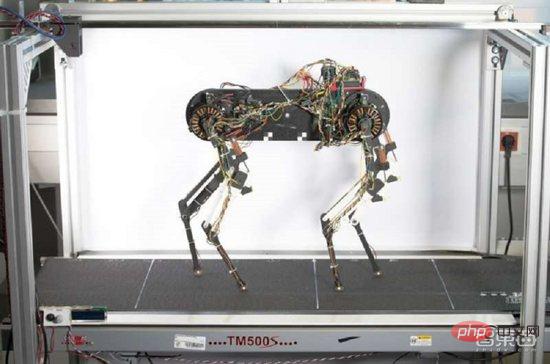Home >Technology peripherals >AI >Can a robot dog learn to walk in one hour? Mimicking animal instincts, research published in Nature sub-journal
Can a robot dog learn to walk in one hour? Mimicking animal instincts, research published in Nature sub-journal
- 王林forward
- 2023-04-09 19:21:011450browse
According to foreign media Tech Xplore, the Max Planck Institute for Intelligent Systems (MPI-IS) in Stuttgart, Germany, invented a small four-legged robot dog named Morti. Learn how to walk on your own.
The paper "Learning Plastic Matching of Robot Dynamics in Closed-loop Central Pattern Generators" illustrating this technology was published in "Learning Plastic Matching of Robot Dynamics in Closed-loop Central Pattern Generators" on July 18 Published in the journal Nature Machine Intelligence, the first author of the paper is Felix Ruppert.
Rupert said: "The robot dog Morti we studied has the same reflexes as animals and can learn how to walk independently from failures."

▲Robotic Dog Morti
1. Get up after falling, Morti can imitate animal learning
There is a nerve called CPG (Central Pattern Generator) in the spinal cord of humans and animals meta network. CPG can help organisms complete rhythmic tasks such as walking, blinking or digestion. This network of neurons can produce periodic muscle contractions without input from the brain.
Rupert installed a virtual spinal cord on Morti's back to simulate the effects of CPG, and installed a sample database in this virtual spinal cord. When Morti walks smoothly, the sensor data on the robot's feet are constantly compared with the data in the CPG sample library to provide a suitable walking posture.
If the robot falls, the learning algorithm optimizes the way it walks by changing the distance and speed at which the legs swing back and forth. During the machine learning process, CPG will send some adaptive motion signals to make the robot walk more smoothly. The core of this machine learning process is to change the output signal of the CPG and monitor under what circumstances the machine will encounter stumbling.

▲Morti optimizes walking based on feedback data
Morti imitates the process of small animals learning to walk. They only find the most effective way after falling continuously. How to use muscles and learn to walk. Rupert said that at first, Morti would fall over, but after about an hour, the algorithm would help Morti find the best way to walk. Rupert also said: "Currently my team is adding more sensors to Morti to expand Mortimer's range of movement. We want to make Morti more like an animal."
2. Efficient and energy-saving, Morti can walk for one hour Afterwards, the energy consumption is reduced by 42%
To walk the same distance, most industrial quadruped robots currently require tens or hundreds of watts of power, but Morti only consumes 5 watts of power.
This is because on the one hand, industrial quadruped robots have a larger volume and weight and require more power to support their movements, and on the other hand, because Morti’s algorithm is more intelligent.
When a general robot walks, machine learning will pre-design the details of each leg's movement through a large amount of calculations, which will consume a lot of power. But after Morti falls while walking, he can readjust his walking angle based on the results of the new algorithm. Morti uses this feedback data to learn how to walk without requiring a lot of calculations. Morti can reduce energy consumption during the process of learning to walk. The study found that after Morti walked for an hour, it consumed 42% less energy than when it first started walking.

▲Morti walks on the treadmill
Dhireesha Kudithipudi, a professor at the University of Texas at San Antonio, said : "Generally speaking, artificial intelligence can learn a specific task very well, but artificial intelligence cannot recalibrate when the environment changes. Morti can autonomously adjust its own movement pattern based on data feedback, and it is possible to recalibrate the environment." will perform better."
Conclusion: Combining the fields of artificial intelligence and biology to explore more possibilities of robots
Rupert's robot dog can perform the same tasks as biological creatures through artificial intelligence algorithms Self-learning. This not only combines machine learning technology, but also involves the biological field.
If this technology can be used on a large scale, it will have two benefits: First, machine learning will be more energy-efficient and consume less energy. Machines no longer have to perform brute force calculations based on large amounts of data, but can become "smarter" through autonomous learning. Second, this technology can inspire the integration of the fields of artificial intelligence and biology.
Currently, this technology can make robot dogs more like animals. In the future, as this technology develops, robots may become more like humans.
The above is the detailed content of Can a robot dog learn to walk in one hour? Mimicking animal instincts, research published in Nature sub-journal. For more information, please follow other related articles on the PHP Chinese website!
Related articles
See more- Technology trends to watch in 2023
- How Artificial Intelligence is Bringing New Everyday Work to Data Center Teams
- Can artificial intelligence or automation solve the problem of low energy efficiency in buildings?
- OpenAI co-founder interviewed by Huang Renxun: GPT-4's reasoning capabilities have not yet reached expectations
- Microsoft's Bing surpasses Google in search traffic thanks to OpenAI technology

